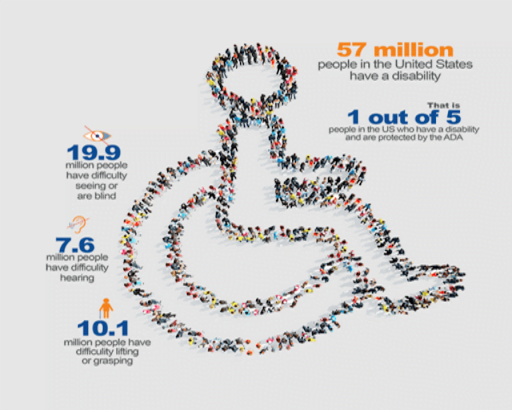In today’s digital age, web accessibility has become more than just a regulatory requirement; it is crucial to providing an inclusive and user-friendly online experience. For individuals with disabilities, navigating the digital landscape can be challenging if websites are not designed with accessibility. In this context, the Americans with Disabilities Act (ADA) significantly ensures businesses and organizations create accessible digital environments.
In recent years, the rise of AI platforms in web development has offered innovative solutions to enhance web accessibility and ADA compliance. This article explores the role of AI in web accessibility and its potential to revolutionize the user experience for all users.
Understanding web accessibility and ADA compliance
Web accessibility goes beyond merely catering to individuals with disabilities; it encompasses the principle of inclusive design, ensuring that all users can access and interact with digital content effortlessly, regardless of their abilities. By making websites accessible, businesses and organizations create an environment where everyone can participate equally, fostering a sense of belonging and empowerment for users with disabilities.
Enacted in 1990, the Americans with Disabilities Act is a groundbreaking civil rights law prohibiting discrimination against individuals with disabilities in various aspects of public life, including employment, transportation, and public accommodations. Over the years, the ADA has evolved to address the digital realm, recognizing that the internet has become a vital aspect of daily life and access to digital content is essential for full participation in society.
Web accessibility is not only a legal requirement but also a matter of social responsibility. When websites are designed with accessibility in mind, they become more usable for everyone, not just individuals with disabilities.
Understanding the impact of web accessibility and the barriers faced by users with disabilities is essential to appreciate the significance of AI solutions.
The role of AI in web accessibility
Artificial intelligence (AI) is revolutionizing various industries as technology evolves, and web accessibility is no exception. AI-driven solutions offer innovative ways to enhance web accessibility, making digital content more inclusive and user-friendly for individuals with disabilities.
AI platforms play a pivotal role in transforming web accessibility in the following ways:
AI-Powered Assistive Technologies
Screen Readers and Natural Language Processing: AI-driven screen readers can analyze and interpret web content, providing auditory cues that assist users with visual impairments in navigating websites seamlessly.
- Speech Recognition and Voice Commands: Conversational AI platforms’ speech recognition capabilities allow users with mobility impairments to interact with websites through voice commands. This robust approach reduces the need for manual navigation.
- AI-Powered Captions and Transcriptions: AI-generated captions and transcriptions for multimedia content facilitate access for users with hearing impairments.
AI-Driven User Interface Enhancements
Adaptive Design and Personalization: AI platforms can adapt websites based on user preferences, making the interface more intuitive and accessible to diverse audiences.
Intelligent Navigation and Menus: AI algorithms can analyze user behavior and preferences to optimize website navigation, ensuring ease of use for all visitors.
AI-Powered Captions and Transcriptions: AI-generated captions and transcriptions for multimedia content facilitate access for users with hearing impairments.
AI-Generated Alt Text and Descriptions
AI can analyze images and videos featured on websites, automatically producing precise and descriptive alternative text. This innovative approach ensures that users who depend on screen readers can easily access visual content.
By generating accurate alt text and descriptions, AI significantly enhances web accessibility, enabling individuals with visual impairments to fully engage with digital media. They will also gain a comprehensive understanding of the visual elements present on a webpage.
Automated Accessibility Testing and Validation
Leveraging AI platforms, web developers can automate the crucial process of accessibility testing and validation. By employing AI-driven solutions, potential accessibility issues can be efficiently identified and addressed, streamlining the development process and ensuring that websites comply with web accessibility standards.
This automation saves time and effort and facilitates the creation of more inclusive digital experiences for users of all abilities. Ultimately, automation outcomes align with the goal of fostering a more accessible and user-friendly online environment.
Advantages of incorporating AI platforms for accessibility
As per data from the U.S. Census Bureau, in 2021, approximately 42.5 million Americans have disabilities constituting approximately 13% of the civilian noninstitutionalized population. According to current estimates, this has increased to around 57 million (20%).
AI-based web development empowers businesses and organizations to create more inclusive and user-friendly digital experiences. The following are the key advantages AI-driven web development brings:
Improved User Experience
Incorporating AI platforms in web accessibility design not only benefits users with disabilities but also improves the overall user experience for all visitors. By ensuring that websites are accessible and intuitive, AI-driven solutions create a more inclusive environment, enhancing user satisfaction and engagement.
Balanced Accessibility and Responsive Design
Responsive web design principles ensure that web pages and content offer optimal viewing experiences across various devices. Meanwhile, accessibility focuses on creating easily navigable content for individuals with disabilities.
By harnessing the power of AI, businesses can strike a balance between these two crucial aspects, seamlessly integrating accessibility features into responsive design and contributing to an enhanced and inclusive user experience.
Cost-Effectiveness and Time Saving
AI-driven accessibility solutions offer cost-effective alternatives to traditional manual approaches. By automating accessibility testing and remediation, businesses can significantly reduce the time and resources required to make their websites compliant, leading to more efficient development processes and ultimately saving costs.
Moreover, investing in ADA compliance can yield a strong return on investment by expanding the potential customer base and mitigating the risk of legal actions related to accessibility non-compliance.
Keeping Pace with Evolving Accessibility Standards
Web accessibility guidelines and standards are continually evolving to accommodate advancements in technology and user needs. AI platforms equipped with machine learning capabilities can adapt to these changes, making it easier for websites to stay up-to-date with the latest accessibility requirements and regulations.
Addressing a Larger Market and Expanding Reach
By prioritizing accessibility through AI platforms, businesses can tap into a larger market segment. Websites that are inclusive and cater to diverse needs attract not only users with disabilities but also those who prefer more user-friendly interfaces. Web accessibility supports business growth as it helps increase web traffic and foster engagement.
Gaining a Competitive Edge in the Digital Landscape
In an increasingly competitive digital world, accessibility can be a significant differentiator for businesses. Those that invest in AI-driven accessibility solutions demonstrate a commitment to inclusivity, fostering a positive brand image that resonates with users and sets them apart from competitors.
For instance, Equally AI’s Flowy consolidates all the necessary tools and resources for developing accessible websites into a single platform. The ChatGPT-based no-code platform is the ideal solution for developers and website owners who seek to design accessible sites without requiring specialized expertise in accessibility.
Best practices for implementing AI-driven web accessibility
Following established guidelines and strategies enables businesses to maximize the benefits of AI in creating more inclusive and user-friendly digital experiences. Adopting the following best practices becomes paramount to ensure successful implementation.
Collaboration between AI Experts and Accessibility Specialists
Effective collaboration between AI experts and accessibility specialists is crucial for successfully implementing AI-driven web accessibility solutions. By bringing together the expertise of AI developers and professionals with in-depth knowledge of accessibility standards, businesses can ensure that their AI platforms are designed with inclusivity in mind, addressing the unique needs of users with disabilities comprehensively.
Thorough Testing and User Feedback
Thorough testing throughout development is essential to identify and rectify potential accessibility issues. Conducting comprehensive tests using various assistive technologies and seeking feedback from users with disabilities helps to validate the effectiveness of AI-driven accessibility features, ensuring that they deliver on their intended purpose of creating a more inclusive digital environment.
Regular Updates and Maintenance
The dynamic nature of the digital landscape and evolving accessibility standards necessitate regular updates and maintenance of AI-driven accessibility features. By staying up-to-date with the latest developments in both AI technology and accessibility guidelines, businesses can guarantee that their AI platforms continue to provide efficient and accurate solutions, thereby sustaining a positive impact on web accessibility over time.
Transparent Documentation and Reporting
Transparency is key when implementing AI-driven web accessibility. By thoroughly documenting the AI processes used to enhance accessibility and reporting on the improvements achieved, businesses can demonstrate their commitment to providing equal access to all users.
This transparency fosters trust with users and helps organizations stay accountable and compliant with accessibility regulations and standards. It also helps prevent ADA non-compliance lawsuits.
Shaping a More Inclusive Web
AI platforms in web development can significantly boost web accessibility and ADA compliance, leading to a more inclusive and user-friendly digital environment. By leveraging AI-powered assistive technologies, enhancing user interface design, and automating accessibility testing, businesses and organizations can create an online space that caters to the needs of all users, regardless of their abilities.
Businesses need to adopt AI solutions responsibly, considering ethical implications and collaborating with accessibility experts to maximize the benefits of AI in enhancing web accessibility. By doing so, we can work towards a future where digital experiences are accessible to everyone.




![Read more about the article ADA Tax Credit: Is Your Business Eligible? [+How To Calculate It]](https://blog.equally.ai/wp-content/uploads/2022/11/amol-tyagi-UZFCQPNc4bs-unsplash-1-e1669293398996-300x172.jpg)
